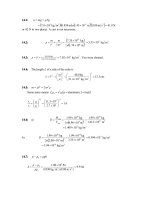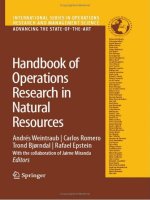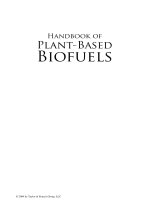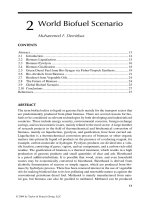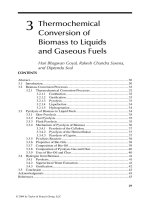Handbook of plant based biofuels - Chapter 14 pdf
Bạn đang xem bản rút gọn của tài liệu. Xem và tải ngay bản đầy đủ của tài liệu tại đây (289.61 KB, 14 trang )
199
14
Lipase-Catalyzed
Preparation of Biodiesel
Rachapudi Badari Narayana Prasad and
Bhamidipati Venkata Surya Koppeswara Rao
ABSTRACT
The drawbacks associated with conventional processes for the preparation of biodie-
sel can be overcome by using lipases as alternate catalysts. Lipases exhibit the ability
to esterify and transesterify both fatty acids and acyl glycerols. Different approaches
reported in the literature for the preparation of biodiesel from various feedstocks
are described in the chapter. The major problem for lipase-catalyzed preparation
of biodiesel is deactivation of the lipase in the presence of short chain alcohols like
methanol and ethanol. Methodologies reported for stabilizing the lipases and the use
of alternate acyl donors are also reviewed.
14.1 INTRODUCTION
The disadvantages caused by physicochemical methods to produce biodiesel can be
overcome by using the lipases as alternate catalysts (Haas and Foglia 2005). Lipases
are generally effective biocatalysts for having substrate specicity, functional group
specicity, and stereo specicity and hence industrial applications of lipases in
the oleochemical industry have become more attractive. The advantages for lipase
CONTENTS
Abstract 199
14.1 Introduction 199
14.2 Pretreatment of Oil and Lipase for Efcient Alcoholysis 200
14.3 Lipase-Catalyzed Alcoholysis of Oil With and Without the Solvent
Medium 201
14.4 Novel Immobilization Techniques for the Stabilization of Lipase 206
14.5 Lipase-Mediated Esterication and Transesterication of Vegetable
Oils Containing Free Fatty Acids and Other Low-Grade Oils Isolated
From Bleaching Earth 207
14.6 Continuous Production of Alkyl Esters Using Packed-Bed Reactors 208
14.7 Alternate Acyl Donors for the Stabilization of Lipases 208
14.8 Conclusions and Future Perspectives 209
References 210
© 2009 by Taylor & Francis Group, LLC
200 Handbook of Plant-Based Biofuels
catalysis over chemical methods in the production of biodiesel from vegetable oils
include the ability to esterify and transesterify both the free fatty acids (FFA) and
acyl glycerols; the production of glycerol as a by-product with minimal water content
and very little or no inorganic contamination; and the lipase catalyst can be reused
several times. However, the use of enzymatic catalysts has some restrictions due to
the high cost of the lipases compared to inorganic catalysts and inactivation of the
lipase by the contaminants in the feedstocks, polar short chain alcohols and the by-
product glycerol.
Although the enzymatic process for the production of biodiesel is still not com-
mercially feasible, a number of studies have shown that the lipases hold promise as
an alternative catalyst to the traditional alkali. These studies mainly describe opti-
mizing the reaction conditions, such as type of enzyme, effect of immobilization of
the lipase on reaction, lipase to substrate ratio, oil to alcohol molar ratio, use of the
solvent and different acyl donors, temperature, time, etc. (Table 14.1). This chap-
ter describes the work carried out so far for the preparation of biodiesel employing
enzymatic approaches.
14.2 PRETREATMENT OF OIL AND LIPASE
FOR EFFICIENT ALCOHOLYSIS
The crude vegetable oils contain several components such as lecithin, FFA, waxes,
unsaponiable matter, and pigments. However, it is necessary to pretreat the oil for
the removal of the lecithin and pigments by employing degumming and bleaching
for efcient conversions during the enzymatic reaction. It is not necessary to remove
the FFA during pretreatment as the lipase has the capability of converting the fatty
acid into methyl esters along with triacylglycerol.
The crude vegetable oils do not undergo enzymatic alcoholysis, or yields are
very low due to the presence of higher amounts of the phospholipids. The inhibi-
tion may be due to the interference of the interaction of the lipase molecule with the
substrates by the phospholipids bound on the immobilized preparation. Crude and
rened soybean oils were subjected to transesterication with methanol using immo-
bilized Candida antarctica (Novozym 435) as the biocatalyst (Du et al. 2004a); the
yield of methyl esters produced from the crude soybean oil was lower than that from
rened soybean oil. The higher the phospholipid content, the lower was the yield of
methyl esters. These ndings clearly indicate that degummed oil is a better substrate
for enzymatic methanolysis.
Several studies were reported for the stabilization or regeneration of the lipase
for reusability. The pretreatment of the lipase by immersing in oils may inuence
the reaction rate of the alcoholysis by improving its activity. A study reported by
Samukawa et al. (2000) involves the incubation of the lipase in methyl oleate for 0.5
h and subsequently in soybean oil for 12 h. The methyl ester content reached 97%
within 3.5 h by step-wise addition of methanol by employing the pretreated lipase.
It was observed that the short chain acyl acceptor glycerol, one of the major by-
products during the transesterication reaction, has serious negative effects on the
performance of the lipases. The glycerol forms a coating over the enzyme and blocks
the active sites, which in turn reduces the activity of the lipase. The treatment of the
© 2009 by Taylor & Francis Group, LLC
Lipase-Catalyzed Preparation of Biodiesel 201
lipases intermittently with isopropanol to remove the glycerol from the reaction sys-
tem proved to be effective in retaining its 95% activity (Du, Xu, and Liu 2003) even
after 10 to 15 batches of the reaction with more than 94% yield of the methyl esters.
In another work, 2-butanol and t-butanol were employed to restore the activity of the
deactivated enzyme to an extent of 56 and 75%, respectively.
The dialysis method using a at sheet membrane module was reported to con-
tinuously remove the glycerol from the reaction system to reduce the inhibitory
effect of the glycerol on the lipase during methanolysis by immobilized C. antarc-
tica employing step-wise as well as continuous methanol feeding (Bela-Bako et al.
2002). Ultrasound pretreatment was also effective in stabilizing the lipase activity
and in turn accelerated the transesterication rate of waste oil with methanol (Hong
and Min-Hua 2005).
Ethanolysis of sunower oil with Mucor mehi lipase did not yield more than
85% even under optimized conditions but the yields were improved by the addition
of silica gel to the reaction medium (Selmi and Thomas 1998). This was due to the
adsorption of the glycerol by the silica gel, which reduced the glycerol deactivation
of the enzyme. The addition of the silica gel was also useful for the promotion of
acyl migration in the transesterication reaction to increase the yield of the biodiesel
when 1,3 specic lipase such as lipozyme TL was used (Du et al. 2005). The biodie-
sel yield was only 66% when 4% lipozyme TL was used, while about 90% biodiesel
yield could be achieved when combining 6% silica gel with 4% lipozyme TL, almost
as high as that of 10% immobilized lipase used for the reaction.
14.3 LIPASE-CATALYZED ALCOHOLYSIS OF OIL
WITH AND WITHOUT THE SOLVENT MEDIUM
The lipase-catalyzed alcoholysis of oil can be achieved with and without the solvent
medium. Early work on the application of lipases from Pseudomonas uorescens,
M. miehei, and Candida sp. for biodiesel preparation was reported using sunower
oil in petroleum ether medium (Mittelbach 1990). Of these, Pseudomonas lipase
gave almost quantitative yields of the biodiesel. When the reaction was carried out
without the organic solvent, only 3% of product was formed during the methanolysis
whereas absolute ethanol, 96% ethanol, and 1-butanol produced 70, 82, and 76% of
the respective esters. The reaction rates with the homologous alcohols revealed that
the reaction rates increased with higher chain length of the alcohol, with or without
the addition of water.
The ability of the lipases in the transesterication of several oils such as the
soybean, rapeseed, olive, etc. with short chain alcohols was studied using M. miehei
and C. antarctica lipases. M. miehei was the most efcient for transesterifying the
triglycerides to their alkyl esters with primary alcohols, whereas C. antarctica was
the most efcient for the branched chain alcohols (Nelson, Foglia, and Marmer
1996). In the presence of hexane medium, 94.8 to 98.5% conversions were achieved
for the primary alcohols and 61.2 to 83.8% for the secondary alcohols. However, in
solvent-free medium, the yields with methanol and ethanol were lower; in particular
the yield with methanol was only 19.4%. Chromobacterium viscosum, C. rugosa,
and porcine pancreas were screened for transesterication reaction of jatropha oil
© 2009 by Taylor & Francis Group, LLC
202 Handbook of Plant-Based Biofuels
TABLE 14.1
Lipase-Mediated Preparation of Biodiesel Using Various Types of Oils, Alcohols, and Lipases
Oil Alcohol Lipase(s) Conditions
Conversion
(%) Remarks Ref.
Crude and rened
soybean
Methanol C. antarctica (Novozym 435) 3 Step methanolysis 94 Pretreatment of enzyme with
crude oil for 120 h resulted in
good yields
Du et al.
(2004a)
Soybean Methanol C. Antarctica (Novozym 435) Oil:methanol, 1:8; lipase:
4 wt% of oil; 30°C, 3.5
h
97 Step-wise addition of methanol,
with and without water; with and
without preincubation of lipase
in methyl oleate and soybean oil
Samukawa et al.
(2000)
Soybean Methanol Thermomyces lanuginosus
(Lipozyme TL IM)
Oil:methanol, 1:4; lipase:
30 wt% of oil; 30–50°C;
12 h
92 Isopropanol helped to recover
glycerol and to stabilize lipase
Du, Xu, and Liu
(2003)
Sunower Methanol C. antarctica (Novozyme 435) Oil:methanol, 1:4; lipase:
7 wt% of oil; water: 400
ppm; 50°C; 16 h
97 Step-wise and continuous addition
of methanol; glycerol removed
by dialysis using a at sheet
membrane module
Bela-Bako et
al. (2002)
Sunower Ethanol Mucor miehei (Lipozyme) Oil:ethanol, 1:3; lipase:
10 wt% of oil; 50°C; 5 h
83 Addition of silica gel improved
the yields of ethyl esters
Selmi and
Thomas (1998)
Soybean Methanol T. lanuginosus (Lipozyme TL) Oil:methanol, 1:3; 6 wt%
silica gel and 4 wt%
immobilized lipase of
oil; 40°C; 48 h
90 Three step-wise additions of
methanol; silica gel promoted
acyl migration and helped to
increase the yield of methyl ester
Du et al. (2005)
© 2009 by Taylor & Francis Group, LLC
Lipase-Catalyzed Preparation of Biodiesel 203
Sunower Methanol,
ethanol
(abs),
ethanol
(96%),
1-propanol,
1-butanol
Pseudomonas
uorescensMucor miehei
(Lipozyme)Candida sp. (SP
382)
Oil:alcohol,1:3 to 1:12;
lipase:10–20 wt% of
oil; solvent medium:
with/without pet. ether;
25–65°C; 5–14 h
3–82 (without
solvent)9–99
(with solvent)
Reaction conducted with or
without addition of water and
solvent
Mittelbach
(1990)
Yellow grease,
tallow fat,
rapeseed, soybean,
olive
Methanol,
ethanol,
isopropanol,
2-butanol
M. miehei (Lipozyme IM 60)
C. antarctica (SP 435)P.
cepaci, Rhizopus delemar,
Geotricum candidum
Oil:alcohol, 1:3; lipase:
10 wt% of oil; hexane as
reaction medium; 45°C;
5 h
Up to 98 M. miehei and C. antarctica were
most efcient for transesterifying
triglycerides with primary and
secondary alcohols, respectively
Nelson, Foglia,
and Marmer
(1996)
Jatropha Methanol,
ethanol
Chromobacterium viscosum,
C. rugosa, porcine pancreas
Oil:alcohol, 1:4; lipase:
10 wt% of oil; 40°C; 8 h
62–92 Reaction carried out with and
without immobilization of lipase
on celite and with and without
water
Shah, Sharma,
and Gupta
(2004)
Castor Ethanol C. antarctica (Novozym 435),
T. lanuginosus (Lipozyme
IM)
Oil:ethanol, 1:10; lipase:
20% of oil; 65°C
Oil:ethanol, 1:3; lipase:
20 wt% of oil: 65°C
81.498 Taguchi experimental design was
adopted; both reactions were
carried out in n-hexane
De Debora et al.
(2004)
Cottonseed Methanol C. antarctica (Novozym 435) Oil:methanol, 1:4; lipase:
30 wt% of oil; 50°C; 7 h
72–94 Free fatty acid content increased
in the product with increasing
enzyme quantity
Köse, Tüter, and
Aksoy (2002)
Mixture of soybean
and rapeseed
Methanol C. Antarctica (Novozym 435),
Rhizomucor miehei,
Rhizopus delemar, Fusarium
heterosporum, Aspergillus
niger
Oil:methanol, 1:3; lipase:
4 wt% of oil; 30°C; 48 h
93–98 Step-wise addition of methanol
with batch and continuous
reaction system
Shimada et al.
(1999)
Watanabe et al.
(2000)
-continued
© 2009 by Taylor & Francis Group, LLC
204 Handbook of Plant-Based Biofuels
TABLE 14.1 (continued)
Lipase-Mediated Preparation of Biodiesel Using Various Types of Oils, Alcohols, and Lipases
Oil Alcohol Lipase(s) Conditions
Conversion
(%) Remarks Ref.
Sunower Triolein Methanol Rhizomucor mieheiP.
uorescens (Amano AK)
Oil:methanol, 1:4.5;
lipase: 10 wt% of oil;
solvent medium: with
and without hexane;
40°C; 24 h
80–90 Step-wise addition of 1 M
equivalent of methanol at 5 h
intervals
Soumanou and
Bornscheuer
(2003)
Soybean Methanol C. rugosa, P. cepacia, P.
uorescens
Oil:methanol, 1:3; lipase:
5 wt% of oil; water:
0–20%; 35°C; 80–100 h
13–90 With and without water, presence
of water prevents the inactivation
of lipase
Kaieda et al.
(2001)
Olive, rapeseed, rice
bran, soybean
Methanol Cryptococcus sp. S-2 (Strain
CS2)
Oil:methanol, 1:4; water:
80 wt% of the substrate
contains 2000 U of
crude lipase; 30°C; 120
h
80 Single-stage addition of methanol Kamini and
Iefuji (2001)
Soybean Methanol,
ethanol
Immobilized P. cepacia Oil:alcohol, 1:7.5; lipase:
5 wt% of oil; water: 5%,
35°C; 1 hOil:alcohol,
1:15.2; lipase: 5 wt% of
oil; water: 3%; 35°C; 1 h
6765 Immobilized lipase was
consistently more active than the
free enzyme
Noureddini,
Gao, and
Philkana
(2005)
Restaurant grease Methanol,
ethanol
P. cepacia (PS-30) Grease:alcohol, 1;4;
lipase: 10 wt% of
grease; 40–70°C; 48 h
60–97 Single-step addition of alcohol Hsu et al. (2003)
Soybean Methanol Immobilized Rhizopus oryzae
cells within biomass support
particles (BSPs)
Oil:methanol, 1:3; lipase:
50 BSPs, 0.1 M acetate
buffer 1.5 ml (15% of
oil); 35°C; 72 h
91.1 Step-wise addition of methanol in
presence of acetate buffer
Ban et al. (2001)
© 2009 by Taylor & Francis Group, LLC
Lipase-Catalyzed Preparation of Biodiesel 205
in a solvent-free system with 10% of the lipase based on the oil (Shah, Sharma, and
Gupta 2004). Among three lipases used, C. viscosum gave good yields (62%) and the
yields were further enhanced (71%) when the enzyme was immobilized on Celite
545. The addition of 1% water into the free enzyme preparation and 0.5% water into
the immobilized enzyme preparation enhanced the yields of biodiesel to 73% and
92%, respectively. The ethanolysis of castor oil was carried out in n-hexane medium
using Novozym 435 and Lipozyme IM. The reactions were carried out in the pres-
ence and absence of water. Under optimum reaction conditions, a conversion of
81.4% was achieved with Novozym 435 and 98% with Lipozyme IM (De Debora
et al., 2004). The yields of biodiesel could be improved using higher dosage of the
enzyme, that is, up to 30% based on the oil, when methanolysis was carried out with
cottonseed oil using immobilized C. antarctica in a solvent-free medium (Köse,
Tüter, and Aksoy 2002). However, the FFA content increased in the product with
increasing enzyme quantity due to the moisture present in the immobilized lipase.
Enzymes are unstable in short chain alcohols in general and the lower yields
of methanolysis could be due to the inactivation of lipase caused by the contact
between the lipase and the insoluble methanol that exists as drops in the oil. Indeed,
when methanolysis of vegetable oils was conducted with immobilized C. antarctica,
the lipase was inactivated irreversibly in the presence of half molar equivalent of
methanol to oil (Shimada et al. 1999). These ndings led to a step-wise incremen-
tal addition of the alcohol to safeguard the lipase from the short chain alcohols. A
three-step addition of one molar equivalent of methanol under optimized conditions
yielded about 98% of biodiesel after 12 h of reaction. Similar results were reported
(Watanabe et al. 2000) for the methanolysis of a mixture of soybean and rapeseed
oils using immobilized C. antarctica by adding the methanol three successive times
in a span of 48 h to get the conversions up to 98.4%. This approach maintained more
than 95% of the ester conversion even after 50 cycles of the reaction.
The methanolysis of sunower oil using immobilized P. uorescens and Rhizo-
mucor miehei in the solvent and solvent-free system was investigated by Soumanou
and Bornscheuer (2003). About 80% conversions were observed when the reaction
was conducted in the presence of n-hexane and petroleum ether. A three-step pro-
tocol with the step-wise addition of one molar equivalent of the methanol at 5 h
intervals reduced the inactivation of the commercial immobilized lipases by the
methanol to obtain better yields.
Kaieda et al. (2001) reported the methanolysis of soybean oil with both 1-3-spe-
cic and nonspecic lipases in a water-containing system without an organic solvent.
Among the nonspecic lipases, C. rugosa, P. cepacia, and P. uorescens exhib-
ited signicantly high catalytic ability and P. cepacia yielded higher contents of the
methyl ester in a reaction mixture with 3 molar equivalents of the methanol to the oil.
Despite the use of 1,3-specic lipase, the methyl ester yields reached 80 to 90% by
step-wise addition of the methanol to the reaction mixture. This was due to the acyl
migration from the sn-2 position to the sn-1 or sn-3 position in partial glycerides,
which occurred spontaneously.
© 2009 by Taylor & Francis Group, LLC
206 Handbook of Plant-Based Biofuels
14.4 NOVEL IMMOBILIZATION TECHNIQUES
FOR THE STABILIZATION OF LIPASE
The key step in the enzymatic processes lies in the successful immobilization of
the enzyme, which will allow for its recovery and reuse. Immobilization is the most
widely used method for enhancing stability in the lipases and to make them more
attractive for industrial use. In addition to the commercial approaches of immobili-
zation, some innovative methods have been reported for biodiesel preparation. In one
such process, phyllosilicate clay saturated with sodium ions was suspended in water
and then exchanged with alkylammonium ions by the addition of cetyltrimethyl
ammonium chloride; this mixture was then used in the entrapment of P. cepacia
with tetramethoxysilane (TMOS) as the polymerization precursor (Hsu et al. 2001).
The resultant phyllosilicate sol-gel matrix-based immobilized enzyme (IM PS-30)
was then used in the transesterication of tallow and grease and the conversions
were more than 95%. In another study, the lipase PS from P. cepacia was entrapped
within a sol-gel polymer matrix, prepared by the polycondensation of hydrolyzed
TMOS and iso-butyltrimethoxysilane (iso-BTMS), and the immobilized lipase was
consistently more active than the free lipase for the transesterication of soybean oil;
it lost very little activity even after repeated uses (Noureddini et al. 2005).
Thermomyces lanuginose and C. antarctica were immobilized on a macro-
porous acrylic resin and IM PS-30 and employed for the preparation of the methyl and
ethyl esters of restaurant grease in solvent-free media employing a one-step addition
of the alcohol. The IM PS-30 was the most effective compared to the other lipases
even though initially the rate of the reaction was slow. The yield of biodiesel was
about 95% after 48 h of reaction. The addition of molecular sieves also improved the
methyl ester yields by 20% in a transesterication reaction catalyzed by IM PS-30. In
another study, Hsu et al. (2003) dened the reaction variables, such as temperature,
effect of solvent, enzyme amount, and mole ratio of reactants, to optimize conditions
for alkyl ester production from restaurant grease using IM PS-30. The immobilized
lipase was active from 40 to 70°C and the ester yields (60 to 97%) were highest using
a grease to alcohol ratio of 1:4 with 10% lipase in the presence of the molecular
sieves.
Rhizopus oryzae cells immobilized in biomass support particles (BSPs) were
utilized as a whole cell biocatalyst for the methanolysis of soybean oil (Ban et al.
2001). The methanolysis was carried out with step-wise addition of methanol in the
presence of 10 to 20% water and the methyl ester yield reached 80 to 90%. In another
study, R. oryzae cells producing 1,3 positional specicity lipase were cultured with
polyurethane foam-based BSPs in an air-lift bioreactor, and the cells immobilized
in the BSPs were used as a whole-cell biocatalyst in a repeated batch-cycle metha-
nolysis reaction of soybean oil (Oda et al. 2005). The whole-cell biocatalyst had a
higher durability in the methanolysis reaction when obtained from the air-lift bio-
reactor cultivation than from the shake-ask cultivation. The whole-cell biocatalyst
promoted the acyl migration of the partial glycerides and the facilitatory effect was
increased by increase in the water content of the reaction mixture, which enhanced
the yield of biodiesel, but it was lost gradually with the increasing number of reaction
cycles. Cross-linking treatment with the glutaraldehyde to R. oryzae cells immobi-
© 2009 by Taylor & Francis Group, LLC
Lipase-Catalyzed Preparation of Biodiesel 207
lized in the BSPs as a whole-cell biocatalyst for biodiesel production improved the
reusability of the enzyme. The methyl ester content reached 70 to 83% in each cycle
using glutaraldehyde-treated lipase, compared to 50% at the sixth batch cycle with-
out glutaraldehyde treatment (Ban et al. 2002).
The ability of a commercial immobilized lipase from R. miehei to catalyze the
transesterication of soybean oil and methanol was investigated by employing the
Response Surface methodology (RSM) and the ve-level ve-factor Central Com-
posite Rotatable Design (CCRD). The parameters evaluated during this study were
the reaction time, temperature, enzyme amount, molar ratio of methanol to soybean
oil, and added water content; the biodiesel yield was 92.2% at optimum conditions
(Shieh, Liao, and Lee 2003).
14.5 LIPASE-MEDIATED ESTERIFICATION AND
TRANSESTERIFICATION OF VEGETABLE OILS
CONTAINING FREE FATTY ACIDS AND OTHER
LOW-GRADE OILS ISOLATED FROM BLEACHING EARTH
Acid oil is a by-product of the vegetable oil process industry, which contains both
FFAs and triglycerides. It could be a cheaper source for the preparation of biodiesel.
The acid oils of corn and sunower contain 75.3% and 55.6% of FFAs and 8.6% and
24.7% triacylglycerols, respectively. The fatty acids of the acid oil were esteried
with straight and branched chain alcohols, such as methanol, n-propanol, n-butanol,
i-butanol, n-amylalcohol, i-amylalcohol, and n-octanol (Tüter et al. 2004) using
immobilized C. antarctica in hexane medium. Under optimum reaction conditions,
the esteried product of the corn acid oil showed 50% methyl ester content and that
of sunower acid showed 63.6% methyl ester content. However, the acid oil of rape-
seed oil was simultaneously esteried and transesteried to fatty acid methyl esters
in quantitative yields using immobilized C. antarctica lipase (Watanabe et al. 2005).
The enzyme was quite stable in both the reaction steps and could be used for more
than 100 cycles without signicant loss of activity. A similar approach was adopted
for both esterication and transesterication of high-FFA (20 to 60%)-containing
rice bran oil using Novozyme 435 and IM 60 (Lai et al. 2005).
The spent bleaching earth produced during the bleaching of vegetable oils con-
tains about 40% of oil and may also be used as a good feedstock for the preparation
of biodiesel. The residual oil present in the spent bleaching earth obtained from
rening of soya, rapeseed, and palm oils was extracted with an organic solvent and
the extracted oils were subjected to methanolysis by R. oryzae in the presence of 75%
water content (by weight of substrate), with a single-step addition of the methanol.
The conversion to methyl esters was 55% with palm oil after 96 h reaction (Pizarro
and Park 2003). In another study, waste activated bleaching earth was effectively
converted to the fatty acid methyl esters using lipase from C. antartica in the pres-
ence of diesel oil or kerosene or n-hexane as the organic solvent (Kojima et al. 2004).
The lipase showed highest stability in the diesel oil. Under optimum reaction condi-
tions, nearly quantitative yields of the fatty acid methyl esters were obtained using
the diesel oil medium.
© 2009 by Taylor & Francis Group, LLC
208 Handbook of Plant-Based Biofuels
14.6 CONTINUOUS PRODUCTION OF ALKYL
ESTERS USING PACKED-BED REACTORS
Owing to the high cost of lipases, the continuous process of producing simple alkyl
esters using immobilized lipases packed in a xed-bed reactor has been looked into
as a feasible process. Three-step ow methanolysis was conducted (Watanabe et al.
2001) using three columns each packed with 3 g immobilized C. antarctica lipase
(15 × 80 mm) and a mixture of the waste oil; 1/3 molar equivalent of the required
methanol was fed into the rst reactor. The eluate was left to stand overnight to
allow the glycerol to separate and a mixture of the resulting rst-step eluate and
another 1/3 molar equivalent of the methanol was then fed into the second reactor.
The third-step methanolysis was similarly performed by feeding another 1/3 molar
equivalent of the methanol to the third reactor. The ow rates in the three reactors
were maintained at 6, 6, and 4 ml/h, respectively. The water (1980 ppm) and FFAs
(2.5%) present in the waste oil had little inuence on the production of biodiesel.
The reaction was carried out with a mixture of rapeseed and soybean oils also. The
yield of methyl ester from the vegetable oil mixture and the waste oil was 95.9 and
90.4%, respectively.
The use of a recirculating packed-column reactor has also been reported for the
transesterication reaction using a phyllosilicate sol-gel immobilized lipase from
Burkholderia cepacia (IM BS-30) as a stationary phase (Hsu et al. 2004). Using
this packed column reactor, grease was transesteried with ethanol with a ow rate
of 30 ml/min in continuous mode without solvent. Under the optimum conditions,
more than 96% yield of the ester was achieved. The enzyme was reused in the reac-
tor for continuous production. The reactor, enzyme bed, and the substrate reservoir
were washed with n-hexane between cycles and the enzyme bed was air dried before
reuse. The ester conversions after ve cycles of enzyme use were normalized, with
the conversion for the rst cycle being set at 100%. The conversion to the esters for
the second cycle decreased to about 90% and then remained constant for the next
three cycles.
Supercritical carbon dioxide as a nonconventional solvent in lipase-catalyzed
reactions has received considerable attention in recent years as it is readily separable
from the reaction medium by post-reaction step-wise depressurization. The esterica-
tion of oleic acid and ethanol was carried out in a continuous packed-bed reactor using
supercritical carbon dioxide as the solvent (Goddard, Bosley, and Al-Duri 2000). The
reported system did undergo substrate inhibition by the ethanol due to the formation
of a dead-end complex between the short chain alcohol (ethanol) and the enzyme,
causing enzyme deactivation. The plug ow reaction design equation succeeded in
describing the performance of the system under the experimental range investigated.
14.7 ALTERNATE ACYL DONORS FOR
THE STABILIZATION OF LIPASES
Short chain alcohols such as methanol and ethanol are commonly used as acyl accep-
tors for biodiesel production. However, the use of excess alcohol leads to inactivation
of the enzyme. In addition, the major by-product glycerol blocks the active sites of
© 2009 by Taylor & Francis Group, LLC
Lipase-Catalyzed Preparation of Biodiesel 209
the enzyme, resulting in low enzyme activity. Novel acyl acceptors such as methyl
acetate, ethyl acetate, and propan-2-ol were reported recently for the interesterica-
tion of various oils into biodiesel. A comparative study was reported recently on the
Novozym 435-catalyzed transesterication of soybean oil with methanol and inter-
esterication with methyl acetate for the production of biodiesel, with a yield of 92%
(Du et al. 2004b). The by-product triacetin obtained during the interesterication
of soybean oil with methyl acetate did not deactivate the enzyme and the enzyme
could be reused continuously for 100 batches. In another study, the activity of differ-
ent lipases, such as Novozyme 435, Lipozyme RM IM, and Lipozyme TL IM, were
compared for the transesterication of soybean oil using methyl acetate as the acyl
acceptor (Xu et al. 2003). The Novozyme 435 gave maximum yield (92%) compared
to others. The same authors later reported the kinetics of this reaction and developed
a three-consecutive reversible reaction model.
Ethyl acetate has also been used as the acyl acceptor for the production of biod-
iesel from the crude oils of jatropha, karanja, and sunower using Novozym 435 and
the yields of ethyl esters were 91.3%, 90.0%, and 92.7%, respectively (Modi et al.
2006). The relative activity of the lipase could be well maintained over 12 repeated
cycles, whereas it reached zero by the sixth
cycle when ethanol was used as an acyl
acceptor. Modi et al. (2007) also reported the use of propan-2-ol as an acyl acceptor
for the Novozyme 435-catalyzed transesterication reaction for the production of
biodiesel from crude jatropha, karanja, and sunower oils, with good yields. Reus-
ability of the lipase was maintained over 12 repeated cycles with propan-2-ol as the
acyl acceptor. Similarly, lipase stability was observed during alcoholysis of safower
oil and triolein with 1-propanol and 1-butanol using free and immobilized P. uo-
rescens, P. cepacia, M. javanicus, C. rugosa, and R. niveus (using porous kaolinite
particle as a carrier) (Iso et al. 2001). The immobilized P. uorescens exhibited high-
est activity in these reactions. The activity of the immobilized lipase was superior
compared to the free lipase. When methanol and ethanol were used, the alcoholysis
reaction proceeded only in an appropriate organic solvent such as 1,4-dioxane to
protect the lipase.
14.8 CONCLUSIONS AND FUTURE PERSPECTIVES
The disadvantages caused by physicochemical catalysts can be overcome by using
lipases for the preparation of biodiesel in simpler and greener methods. Several
lipases can be employed either in free form or in immobilized state for this purpose.
Immobilized lipases can be used for the preparation of alkyl esters from vegetable
oils and free fatty acids and the enzyme can be used in several cycles. However, the
reaction time is still longer compared to the alkali-catalyzed processes. Most of the
lipase-mediated transesterication reactions reported for biodiesel preparation are
with soybean and sunower oils. Jatropha, karanja, canola, castor, and cottonseed
are other potential candidates. As the lipases can simultaneously esterify and trans-
esterify the FFA and triacylglycerols, low-quality oils such as high-FFA oils, acid
oils, restaurant greases, and oils isolated from spent bleaching earth can also be
converted into biodiesel in reasonably good yields.
© 2009 by Taylor & Francis Group, LLC
210 Handbook of Plant-Based Biofuels
The short chain alcohols such as methanol and ethanol as acyl donors lead to inac-
tivation of lipases. The major by-product glycerol also blocks the active sites of the
enzymes, resulting in low lipase activity. Novel acyl acceptors such as methyl acetate,
ethyl acetate, and propane-2-ol are alternatives to safeguard the activity of the lipases.
The cost of lipase production is still the main obstacle to commercializing the lipase-
catalyzed process for biodiesel production. However, hopefully in the near future, this
can be overcome and biodiesel production based on lipase commercialized.
REFERENCES
Ban, K., M. Kaieda, T. Matsumoto, A. Kondo, and H. Fukuda. 2001. Whole cell biocatalyst
for biodiesel fuel production utilizing Rhizopus oryzae cells immobilized within bio-
mass support particles. Biochemical Engineering Journal 8: 39–43.
Ban, K., S. Hama, K. Nishizuka, M. Kaieda, T. Matsumoto, A. Kondo, H. Noda, and H.
Fukuda. 2002. Repeated use of whole-cell biocatalysts immobilized within biomass
support particles for biodiesel fuel production. Journal of Molecular Catalysis B:
Enzymatic 17: 157–165.
Bela-Bako, K., F. Kovacs, L. Gubicza, and J. Hancsok. 2002. Enzymatic biodiesel produc-
tion from sunower oil by Candida antarctica lipase in a solvent-free system. Bioca-
talysis and Biotransformation 20: 437–439.
De Debora, O., M. Di Luccio, F. Carina, D. R. Clarissa, B. J. Paulo, L. Nadia, M. Silvana, A.
Cristiana, and J. V. de Oliveira. 2004. Optimization of enzymatic production of biodie-
sel from castor oil in organic solvent medium. Applied Biochemistry and Biotechnol-
ogy 115: 771–780.
Du, W., Y. Xu, and D. Liu. 2003. Lipase-catalyzed transesterication of soya bean oil for
biodiesel production during continuous batch operation. Biotechnology and Applied
Biochemistry 38: 103–106.
Du, W., Y. Xu, J. Zeng, and D. Liu. 2004a. Novozym 435-catalyzed transesterication of
crude soya bean oils for biodiesel production in a solvent-free medium. Biotechnology
and Applied Biochemistry 40: 187–190.
Du, W., Y. Xu, D. Liu, and J. Zeng. 2004b. Comparative study on lipase-catalyzed transfor-
mation of soybean oil for biodiesel production with different acyl acceptors. Journal of
Molecular Catalysis B: Enzymatic 30: 125–129.
Du, W., Y Y. Xu, D. Liu, and Z B. Li. 2005. Study on acyl migration in immobilized lipozyme
TL-catalyzed transesterication of soybean oil for biodiesel production. Journal of
Molecular Catalysis B: Enzymatic 37: 68–71.
Goddard, R., J. Bosley, and B. Al-Duri. 2000. Lipase-catalyzed esterication of oleic acid
and ethanol in a continuous packed bed reactor, using supercritical CO
2
as solvent:
Approximation of system kinetics. Journal of Chemical Technology and Biotechnol-
ogy 75: 715–721.
Haas, M. J. and T. A. Foglia. 2005. Alternate feedstocks and technologies for biodiesel pro-
duction. In The Biodiesel Handbook, ed. G. Knothe, J. Gerpen, and J. Krahl, 42–61.
Champaign, IL: AOCS Press.
Hong, W. and Z. Min-Hua. 2005. Effect of ultrasonic irradiation on enzymatic transesteri-
cation of waste oil to biodiesel. Preprints of Symposia – American Chemical Society,
Division of Fuel Chemistry, 50: 773–774.
Hsu, A F., K. C. Jones, W. N. Marmer, and T. A. Foglia. 2001. Production of alkyl esters
from tallow and grease using lipases immobilized in a phyllosilicate sol-gel. Journal of
American Oil Chemists’ Society 78: 585–588.
© 2009 by Taylor & Francis Group, LLC
Lipase-Catalyzed Preparation of Biodiesel 211
Hsu, A F., K. C. Jones, T. A. Foglia, and W. N. Marmer. 2003. Optimization of alkyl esters
from grease using phyllosilicate sol-gel immobilized lipase. Biotechnology Letters 25:
1713–1716.
Hsu, A F., K. C. Jones, T. A. Foglia, and W. N. Marmer. 2004. Continuous production of
ethyl esters of grease using an immobilized lipase. Journal of American Oil Chemists’
Society 81: 749–752.
Iso, M., B. Chen, M. Eguchi, T. Kudo, and S. Shrestha. 2001. Production of biodiesel fuel
from triglycerides and alcohol using immobilized lipase. Journal of Molecular Cataly-
sis B: Enzymatic 16: 53–58.
Kaieda, M., T. Samukawa, A. Kondo, and H. Fukuda. 2001. Effect of methanol and water
contents on production of biodiesel fuel from plant oil catalyzed by various lipases in a
solvent-free system. Journal of Bioscience and Bioengineering 91: 12–15.
Kamini, N. R. and H. Iefuji. 2001. Lipase-catalyzed methanolysis of vegetable oils in aqueous
medium by Cryptococcus sp. S-2, Process Biochemistry 37: 405–410.
Kojima, S., D. Du, M. Sato, and E. Y. Park. 2004. Efcient production of fatty acid methyl
ester from waste activated bleaching earth using diesel oil as organic solvent. Journal
of Bioscience and Bioengineering 98: 420–424.
Köse, Ö., M. Tüter, and H. A. Aksoy. 2002. Immobilized Candida antarctica lipase-cata-
lyzed alcoholysis of cotton seed oil in a solvent-free medium. Bioresource Technology
83: 125–129.
Lai, C C., S. Zullaikah, S. R. Vali, and Y. H. Juyl. 2005. Lipase-catalyzed production of
biodiesel from rice bran oil. Journal of Chemical Technology and Biotechnology 80:
331–337.
Mittelbach, M. 1990. Lipase catalyzed alcoholysis of sunower oil. Journal of American Oil
Chemists’ Society 67: 168–170.
Modi, M. K., J. R. C. Reddy, B. V. S. K. Rao, and R. B. N. Prasad. 2006. Lipase-mediated
transformation of vegetable oils into biodiesel using propan-2-ol as acyl acceptor. Bio-
technology Letters 28: 637–640.
Modi, M. K., J. R. C. Reddy, B. V. S. K. Rao, and R. B. N. Prasad. 2007. Lipase-mediated con-
version of vegetable oils into biodiesel using ethyl acetate as acyl acceptor. Bioresource
Technology 98: 1260–1264.
Nelson, L. A., T. A. Foglia, and W. N. Marmer. 1996. Lipase-catalyzed production of biodie-
sel. Journal of American Oil Chemists’ Society 73: 1191–1195.
Noureddini, H., X. Gao, and R. S. Philkana. 2005. Immobilized Pseudomonas cepacia lipase
for biodiesel fuel production from soybean oil. Bioresource Technology 96: 769–777.
Oda, M., K. Masaru, H. Shinji, Y. Hideki, K. Akihiko, I. Eiji, and F. Hideki. 2005. Facili-
tatory effect of immobilized lipase-producing Rhizopus oryzae cells on acyl migration
in biodiesel-fuel production. Biochemical Engineering Journal 23: 45–51.
Pizarro, A. V. L. and E. Y. Park. 2003. Lipase-catalyzed production of biodiesel fuel from
vegetable oils contained in waste activated bleaching earth. Process Biochemistry 38:
1077–1082.
Samukawa, T., M. Kaieda, T. Matsumoto, K. Ban, A. Kondo, Y. Shimada, H. Noda, and
H. Fukuda. 2000. Pretreatment of immobilized Candida antarctica lipase for biod-
iesel fuel production from plant oil. Journal of Bioscience and Bioengineering 90:
180–183.
Selmi, B. and D. Thomas. 1998. Immobilized lipase-catalyzed ethanolysis of sunower oil in
a solvent-free medium. Journal of American Oil Chemists’ Society 75: 691–695.
Shah, S., S. Sharma, and M. N. Gupta. 2004. Biodiesel preparation by lipase-catalyzed trans-
esterication of jatropha oil. Energy Fuels 18: 154–159.
Shieh, C J., H F. Liao, C C. Lee. 2003. Optimization of lipase-catalyzed biodiesel by
response surface methodology. Bioresource Technology 88: 103–106.
© 2009 by Taylor & Francis Group, LLC
212 Handbook of Plant-Based Biofuels
Shimada, Y., Y. Watanabe, T. Samukawa, A. Sugihara, H. Noda, H. Fukuda, and Y. Tomi-
naga. 1999. Conversion of vegetable oil to biodiesel using immobilized Candida ant-
arctica lipase. Journal of American Oil Chemists’ Society 76: 789–793.
Soumanou, M. M. and U. T. Bornscheuer. 2003. Improvement in lipase-catalyzed synthesis
of fatty acid methyl esters from sunower oil. Enzyme and Microbial Technology 33:
97–103.
Tüter, M., H. A. Aksoy, E. E. Gilbaz, and E. Kurşun. 2004. Synthesis of fatty acid esters from
acid oils using lipase B from Candida Antarctica. European Journal of Lipid Science
and Technology 106: 513–517.
Watanabe, Y., Y. Shimada, A. Sugihara, H. Noda, H. Fukuda, and Y. Tominaga. 2000. Con-
tinuous production of biodiesel fuel from vegetable oil using immobilized Candida
antarctica lipase. Journal of American Oil Chemists’ Society 77: 355–360.
Watanabe, Y., Y. Shimada, A. Sugihara, and Y. Tominaga. 2001. Enzymatic conversion of
waste edible oil to biodiesel fuel in a xed-bed bioreactor. Journal of American Oil
Chemists’ Society 78: 703–707.
Watanabe, Y., P. Pinsirodom, T. Nagao, T. Kobayashi, Y. Nishida, Y. Takagi, and Y. Shimada.
2005. Production of FAME from acid oil model using immobilized Candida antarctica
lipase. Journal of American Oil Chemists’ Society 82: 825–831.
Xu, Y., W. Du, D. Liu, and J. Zeng. 2003. A novel enzymatic route for biodiesel production
from renewable oils in a solvent-free medium. Biotechnology Letters 25: 1239–1241.
© 2009 by Taylor & Francis Group, LLC
